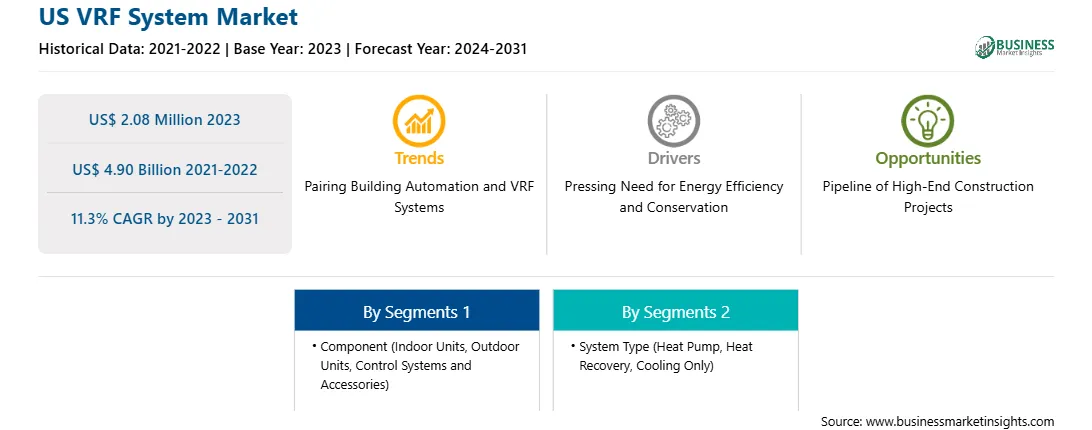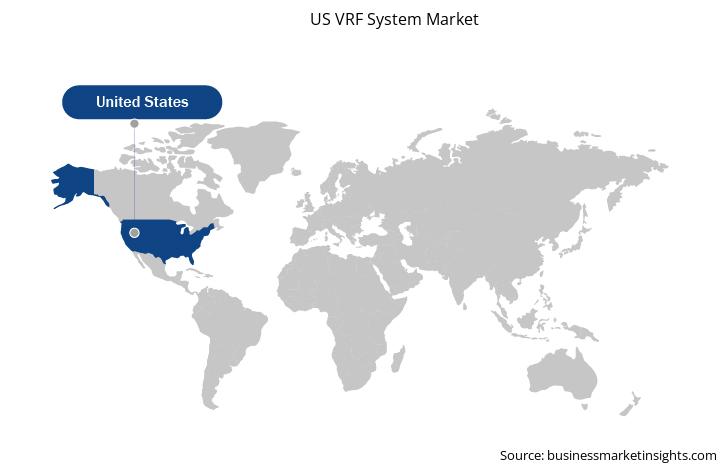The US VRF System Market size was valued at US$ 2.08 million in 2023 and is expected to reach US$ 4.90 billion by 2031. The US VRF System Market is estimated to record a CAGR of 11.3% from 2023 to 2031.
The rapid urbanization and development of commercial, industrial, and residential projects drive the VRF systems market growth in the US. Compact size and flexibility are among the prominent advantages of these systems, owing to which they don't need large maintenance rooms or service shafts. Since VRF systems do not require ducts and use relatively small air handlers, they provide more flexibility for handler locations. Moreover, they don't need distribution fans and large pipes for the circulation of fluids and water pumps. These systems have compact air handlers, which are quieter and smaller than those associated with large central units and extensive ductwork. Thus, residential and commercial buildings will not experience loud AC noise disrupting business. These advantages propel the demand for VRF systems in commercial, residential, and industrial buildings across the US.
The US government provides incentives to encourage the use of renewable resources and promote practices contributing to energy efficiency. The government emphasizes on monitoring HVAC system performance at regular intervals in response to rising concerns about global warming. Standardizing production procedures of HVAC systems and their components, such as VRF systems, i.e., the supply side, has significantly mitigated environmental risks and reduced the burden posed by efficiency criteria on the demand side. According to the US Energy Information Administration's report, projected changes in cooling degree days in the US are expected to drive a 71% increase in household cooling demand by 2050. Commercial buildings are projected to see a 30% increase in cooling demand over the same period. In March 2023, the US finalized new energy efficiency standards for room air conditioners. These standards will go into effect in 2026 and are expected to result in reduced home electricity bills and carbon pollution. The VRF systems are widely used in such cases. Thus, global warming and the resulting harsh climatic conditions, the continuously growing real estate sector, and the desire for energy-efficient equipment contribute to the US VRF system market growth.
Based on system type, the market is categorized into heat pump, heat recovery, and cooling only. The heat pump segment held the largest US VRF System Market share in 2023. Heat pump VRF systems are the most common type and can either heat or cool a building, but they can’t perform both of these functions simultaneously. In the heating mode, the system extracts heat from the outdoor air and transfers it indoors via the refrigerant. In cooling mode, it reverses the process, removing heat from the indoor air and releasing it outside. These systems are ideal for environments where heating or cooling is needed one at a time throughout the building. For instance, these are used in office buildings, retail spaces, and residential buildings where different areas typically require uniform temperature settings. Heat pump systems are energy-efficient due to the use of a variable-speed compressor that adjusts the refrigerant flow based on demand. Moreover, they are simple to install and maintain compared to more complex VRF systems.
FUJITSU GENERAL, Daikin Industries Ltd, Carrier Global Corp., LG Electronics Inc., Panasonic Holdings Corp., Samsung Electronics Co Ltd., Mitsubishi Electric Corp., Lennox International Inc., Trane Technologies Plc, and Robert Bosch GmbH are among the prominent players profiled in the US VRF System Market report. Several other major players were also studied and analyzed in the US VRF System Market report to get a holistic view of the market and its ecosystem.
The overall US VRF System Market share has been derived using both primary and secondary sources. Exhaustive secondary research has been conducted using internal and external sources to obtain qualitative and quantitative information related to the US VRF System Market. The process also helps obtain an overview and forecast of the market with respect to all the market segments. Also, multiple primary interviews have been conducted with industry participants to validate the data and gain analytical insights. This process includes industry experts such as VPs, business development managers, market intelligence managers, and national sales managers, along with external consultants such as valuation experts, research analysts, and key opinion leaders, specializing in the US VRF System Market.
Strategic insights for the US VRF System provides data-driven analysis of the industry landscape, including current trends, key players, and regional nuances. These insights offer actionable recommendations, enabling readers to differentiate themselves from competitors by identifying untapped segments or developing unique value propositions. Leveraging data analytics, these insights help industry players anticipate the market shifts, whether investors, manufacturers, or other stakeholders. A future-oriented perspective is essential, helping stakeholders anticipate market shifts and position themselves for long-term success in this dynamic region. Ultimately, effective strategic insights empower readers to make informed decisions that drive profitability and achieve their business objectives within the market.

| Report Attribute | Details |
|---|---|
| Market size in 2023 | US$ 2.08 Million |
| Market Size by 2031 | US$ 4.90 Billion |
| Global CAGR (2023 - 2031) | 11.3% |
| Historical Data | 2021-2022 |
| Forecast period | 2024-2031 |
| Segments Covered |
By Component
|
| Regions and Countries Covered | United States
|
| Market leaders and key company profiles |
The geographic scope of the US VRF System refers to the specific areas in which a business operates and competes. Understanding local distinctions, such as diverse consumer preferences (e.g., demand for specific plug types or battery backup durations), varying economic conditions, and regulatory environments, is crucial for tailoring strategies to specific markets. Businesses can expand their reach by identifying underserved areas or adapting their offerings to meet local demands. A clear market focus allows for more effective resource allocation, targeted marketing campaigns, and better positioning against local competitors, ultimately driving growth in those targeted areas.

The US VRF System Market is valued at US$ 2.08 Million in 2023, it is projected to reach US$ 4.90 Billion by 2031.
As per our report US VRF System Market, the market size is valued at US$ 2.08 Million in 2023, projecting it to reach US$ 4.90 Billion by 2031. This translates to a CAGR of approximately 11.3% during the forecast period.
The US VRF System Market report typically cover these key segments-
The historic period, base year, and forecast period can vary slightly depending on the specific market research report. However, for the US VRF System Market report:
The US VRF System Market is populated by several key players, each contributing to its growth and innovation. Some of the major players include:
The US VRF System Market report is valuable for diverse stakeholders, including:
Essentially, anyone involved in or considering involvement in the US VRF System Market value chain can benefit from the information contained in a comprehensive market report.